System and method for laser welding foils
a laser welding and foil technology, applied in the field of welding, can solve the problems of pin hole defects, undesirable welds, discoloration of foil materials, etc., and achieve the effect of high thermal conductivity
- Summary
- Abstract
- Description
- Claims
- Application Information
AI Technical Summary
Problems solved by technology
Method used
Image
Examples
Embodiment Construction
[0018] In FIG. 2a, an exemplary embodiment of the invention is shown as a welding setup including a top foil 202 positioned over a bottom foil 204. These foils are further positioned over support plate 210. To obtain an edge weld between top foil 202 and bottom foil 204, a laser 206 is used to apply laser beam 208 across weld line 212. Weld line 212 may be positioned, for example, at a distance from the edge of top foil 202 so that the diameter of the resulting melt pool does not substantially reach the edge, where it may cause an undesirable beading of the top foil material. Alternatively, the welding conditions may be controlled such that the melt pool reaches the edge of top foil 202, but does not bead excessively. Additionally, it is noted that the present exemplary welding setup may also be used with the weld line located in a central portion of the foils.
[0019] In their article MICRO-WELDING OF THIN FOIL WITH DIRECT DIODE LASER (Proceedings of SPIE Vol. 5063 Fourth Internatio...
PUM
| Property | Measurement | Unit |
|---|---|---|
| power | aaaaa | aaaaa |
| power | aaaaa | aaaaa |
| wavelength | aaaaa | aaaaa |
Abstract
Description
Claims
Application Information
 Login to View More
Login to View More - R&D
- Intellectual Property
- Life Sciences
- Materials
- Tech Scout
- Unparalleled Data Quality
- Higher Quality Content
- 60% Fewer Hallucinations
Browse by: Latest US Patents, China's latest patents, Technical Efficacy Thesaurus, Application Domain, Technology Topic, Popular Technical Reports.
© 2025 PatSnap. All rights reserved.Legal|Privacy policy|Modern Slavery Act Transparency Statement|Sitemap|About US| Contact US: help@patsnap.com



